March 14: We spent a day at the campsite watching the cold rain fall and resting. Macon has a lot of attractions, but after our long drive, we lacked motivation.
However, on Tuesday, we set off to see what there is to see. We started with a lunch buffet at the Macon Mall. I am beginning to believe in “the new south”. This was the most integrated dining experience I have ever had – both the staff and the clientele were about 50% white and about 50% African-American. Since RV parks are probably the whitest places in American, it was really very noticeable to be in such an integrated environment. The food was also very good. Of course the problem with a buffet with good food is that it is hard to waddle out after the meal.
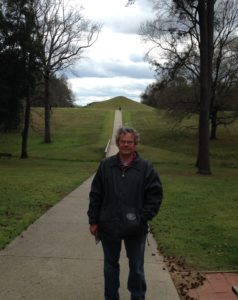 We then headed for a remarkable archeological site, the Ocmulgee National Monument. This is a set of ancient mounds. Although they are grass-covered piles of dirt, they are huge. And a map of the site is very reminiscent of the Pyramids at Mexico City, with a huge temple mound at the end of a large rectangle surrounded by smaller mounds.
We then headed for a remarkable archeological site, the Ocmulgee National Monument. This is a set of ancient mounds. Although they are grass-covered piles of dirt, they are huge. And a map of the site is very reminiscent of the Pyramids at Mexico City, with a huge temple mound at the end of a large rectangle surrounded by smaller mounds.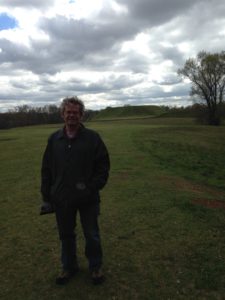
The site was occupied by humans going back to the Clovis culture (13000 years ago). The mounds were built about 1000 years ago by the Mississipians. They must have had a highly developed society to organize moving such huge amounts of earth with no draft animals, levers or wheels. Their culture was first described to Europeans by the DeSoto expedition (1439) which was seeking gold. Instead, they found death and brought death with them in the form of devastating epidemics.
Around 1690, a British trading post was established near the site, which by then was occupied by the modern Ocmulgee nation, also known as the Creeks. When the trading post was abandoned (before the Revolutionary War) its location was lost to history. Its remains were found during archeological excavations of the mound site in the 1930s. From this period until the 1820s, the usual sad tale of wars, broken treaties, illegal land sales reduced the Creek lands until in 1836 they were expelled – many followed their own “Trail of Tears” to Oklahoma. However, they retained their connection to the mound site as a sacred site for the nation. Description of the site when it was active and intact comes from 1774, when it was visited by William Bartram, a naturalist.
By the 1830s, much of the land had become part of the city of Macon and was being used for industrial and agricultural purposes, despite the recognition that this was an archeological site. Needless to say, this ruined some of the mounds. 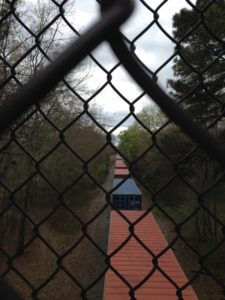 In 1843, a railroad line was constructed that cut right through the site and through several mounds. This both exposed the archeological value of the site and destroyed many artifacts, including 2 of the mounds – one of which was a burial site. The line is still used – the photo shows a container freight car going through.
In 1843, a railroad line was constructed that cut right through the site and through several mounds. This both exposed the archeological value of the site and destroyed many artifacts, including 2 of the mounds – one of which was a burial site. The line is still used – the photo shows a container freight car going through.
Two Civil War battles also occurred at the site.
In the 1920s, three local residents spearheaded a move to preserve the remainder of the site, and recruited Smithsonian archeologists to assist. The site was established as Ocmulgee National Monument in 1936. Between 1933-36, the biggest archeological excavation ever carried out in the US was done with 800 workers recruited into the various post-depression New Deal civilian work corps, under the supervision of a Smithsonian archeologist Kelly, who must have had manic energy to catalog the 100s of thousands of artifacts discovered. The Civilian Conservation Corp continued the work and developed visitor facilities from 1937-41. Excavations ended when the US entered WWII in 1941 and have not been resumed at the request of the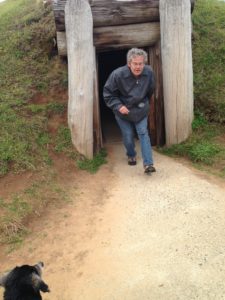 Creek Nation, which still considers the site sacred.
Creek Nation, which still considers the site sacred.
The National Monument has a very good Visitor Center, which displays some of the artifacts and highlights the native American history. I found the display of spear and arrow heads through history to be especially interesting. You can also walk to and on the mounds. One mound was found to be some type of council house – entry is permitted into the chamber.
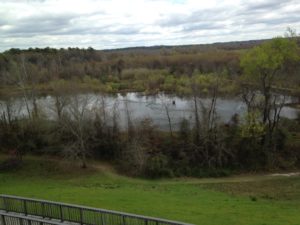 As well, the National Monument has a number of hiking trails. I was quite amazed to see signs warning that alligators are common, as this is well out of the coastal plain and into the rolling hills of western Georgia. However, with temperatures in the 40’s, we did not see any gators.
As well, the National Monument has a number of hiking trails. I was quite amazed to see signs warning that alligators are common, as this is well out of the coastal plain and into the rolling hills of western Georgia. However, with temperatures in the 40’s, we did not see any gators.
All the Macon attractions close at 5:00. It was already 4:00 when we left Ocmulgee, so we headed downtown to visit the Visitor Center and see the town. Macon is really very attractive, with wide streets, some older buildings and boulevards. Unfortunately, some pretty big swaths of the downtown seem to be failing with empty storefronts. It is hard to say whether Macon is dying or becoming revitalized.
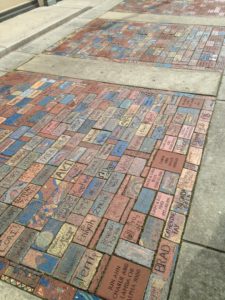
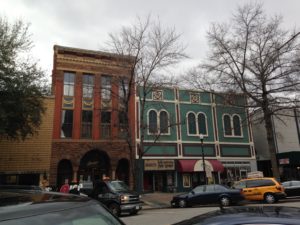
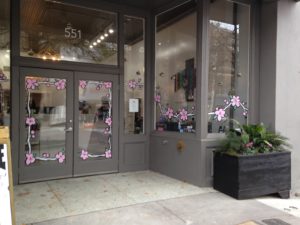 According to the website, Macon has 350,000 cherry trees. I am not sure how this compares with DC, but the annual cherry blossom festival is a very big deal here. It is coming up in 2 weeks, and already most of the downtown stores have blossoms painted on their windows and goods with blossoms (such as T-shirts and paintings) prominently displayed.
According to the website, Macon has 350,000 cherry trees. I am not sure how this compares with DC, but the annual cherry blossom festival is a very big deal here. It is coming up in 2 weeks, and already most of the downtown stores have blossoms painted on their windows and goods with blossoms (such as T-shirts and paintings) prominently displayed.
Ever since our excursion with Anne, we have been looking for binoculars. Chuck recognized the name of a store as we were wandering downtown, and we are now the proud owners of 2 pairs of fairly good binoculars. We were quite lucky – the store no longer carries binoculars because they are so durable that there are seldom repeat customers. However, they had several “vintage” pairs that were gathering dust under the counter – i.e. they were about 20 years old but never out of the box. They were happy to sell them to us for half price and we are happy to have them for our hikes.
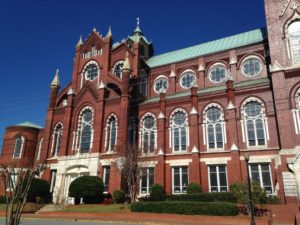 On
On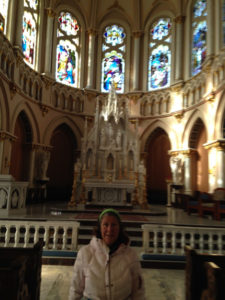
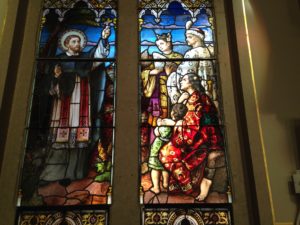 Wednesday we set out to see the rest of our priority Macon attractions. We started at the Catholic church, which rivals the cathedrals of Europe. We were very taken with the detail in the stained glass windows, which included embroidery and lace on the robes of the various saints.
Wednesday we set out to see the rest of our priority Macon attractions. We started at the Catholic church, which rivals the cathedrals of Europe. We were very taken with the detail in the stained glass windows, which included embroidery and lace on the robes of the various saints.
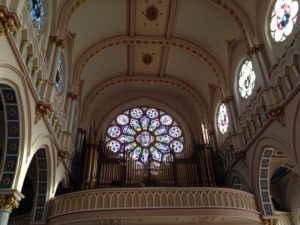
We then went to the premier mansion in Macon, Hay House. 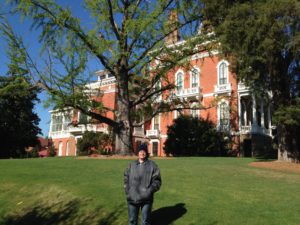
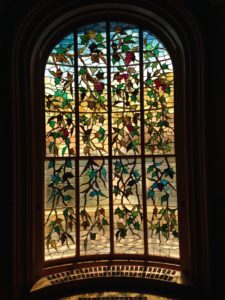
This house was built in the 1830’s by a wealthy jeweler and investor, Johnson.
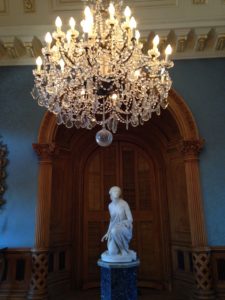
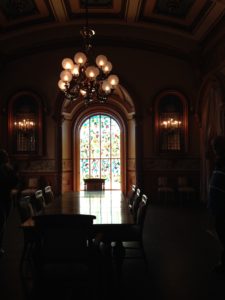 He and his much younger wife were very interested in both art and technology and spent 3 years in Europe, collecting art and ideas. The house is huge (of course) and had a large room with natural light to house their artwork. As well, the house had an advanced ventilation system, central heat, hot and cold running water, and a larder designed to keep vermin and mold at bay.
He and his much younger wife were very interested in both art and technology and spent 3 years in Europe, collecting art and ideas. The house is huge (of course) and had a large room with natural light to house their artwork. As well, the house had an advanced ventilation system, central heat, hot and cold running water, and a larder designed to keep vermin and mold at bay. 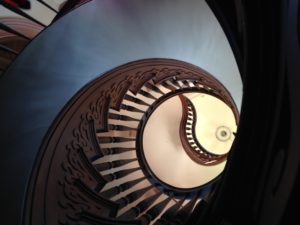 They also had beautiful wood and glass pocket doors – even in the rooms with curved walls. However, all their wealth and technology did not save them from losing their first 4 children all before the age of 2. The last 2 survived and split the estate – one retaining the house. Her offspring sold the house to the Hays. When the Hays offspring could not longer sustain the house as a museum, they gave it to the Georgia Historical Trust, which has had more success in maintaining and marketing the house.
They also had beautiful wood and glass pocket doors – even in the rooms with curved walls. However, all their wealth and technology did not save them from losing their first 4 children all before the age of 2. The last 2 survived and split the estate – one retaining the house. Her offspring sold the house to the Hays. When the Hays offspring could not longer sustain the house as a museum, they gave it to the Georgia Historical Trust, which has had more success in maintaining and marketing the house.
We continue to be amazed at what these wealthy tycoons built and the ingenuity that they brought to the projects. The architecture of the house is quite spectacular.
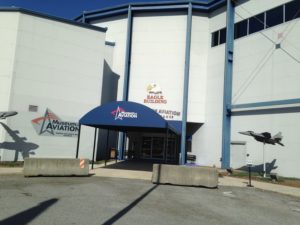 After lunch Chuck and I parted ways. Chuck here: I went to the air museum at Robbins Air Force Base, which is the second largest one in the country. They had a huge number of planes there and I could not do justice to all of them in the time I was there. The highlight for me was the SR-71 Blackbird (picture below).
After lunch Chuck and I parted ways. Chuck here: I went to the air museum at Robbins Air Force Base, which is the second largest one in the country. They had a huge number of planes there and I could not do justice to all of them in the time I was there. The highlight for me was the SR-71 Blackbird (picture below).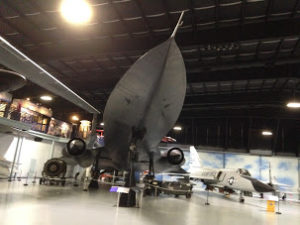
This is the actual plane that still holds the world speed record at about 2170 mph. It is mostly titanium and has 2 large engines. They operate as a turbofan jet at low speeds and as a ramjet at high speeds. The SR-71 also flew from Los Angeles to Washington DC in 1 hour and 4 minutes, which is incredible.
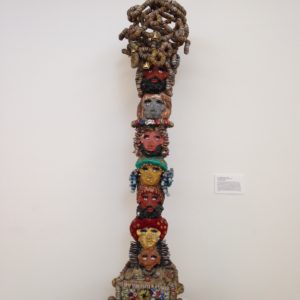 (Naomi) I went to the Tubman Museum, which is an eclectic assortment of African-American collections, including an interesting contemporary art collection, an exhibit of some of the inventions and technological advances created by African-Americans (including some types of refrigeration, an enhancement to the rotary lawn mower, a method for refining sugar, etc, but notably not the Otis safety elevator), As well there was a short film about the daring escape of a Macon slave couple. She, the daughter of her master, was very fair and passed herself off as an ailing young man accompanied by her slave (her husband) going to a hospital in Philadelphia. Due to the Fugitive Slave Act they eventually moved to England but returned to the US after the Civil War.
(Naomi) I went to the Tubman Museum, which is an eclectic assortment of African-American collections, including an interesting contemporary art collection, an exhibit of some of the inventions and technological advances created by African-Americans (including some types of refrigeration, an enhancement to the rotary lawn mower, a method for refining sugar, etc, but notably not the Otis safety elevator), As well there was a short film about the daring escape of a Macon slave couple. She, the daughter of her master, was very fair and passed herself off as an ailing young man accompanied by her slave (her husband) going to a hospital in Philadelphia. Due to the Fugitive Slave Act they eventually moved to England but returned to the US after the Civil War.
Another interesting exhibit was about the use of chain gangs after Reconstruction as forced labor and to suppress black men. Investigative reporter John Spivak was able to gain access to the prisons and photographed the appalling conditions under which the men lived and worked. He also photographed prisoners being “punished” (i.e. tortured). These photos led to reforms of the system so that there was at least some oversight.
In the past year I read Steinbeck’s “The Grapes of Wrath”, Upton Sinclair’s “The Jungle” and viewed Spivak’s chain gang photos. It makes me realize the important role that investigative reporting has had in promoting civil rights and social justice.
After looking at the exhibits, I returned to the museum office and chatted with the attendant. She asked if I had any questions about the exhibit. I said that I had instead a question about a difference between northern and southern culture. Without further prompting, she said”You mean: Yes ma’am; no ma’am.” It turns out that she was from Long Island. Not only did she have to adjust to the constant use of “ma’am” (which apparently is how all adult women are addressed in Georgia, but conveys exaggerated respect or very old age in the northeastern US) but she had to give up use of her first name unless it was proceeded by Miz, as in Miz Naomi. As well, everyone she met wanted to know if she had joined a church yet. Maybe the south is not yet quite as “new” as I thought.
Chuck and I joined up later in the afternoon (as we have only one car) and decided to visit Mercer University for a stroll and to try out our new binoculars. The campus is very pretty. We identified 3 types of bird we were previously unfamiliar with and feel like we have a handle on binocular use, as well as the birding app that Chuck downloaded.
We ended our visit with another trip to the buffet. It is a good thing for our weight that we are leaving Macon tomorrow.

Enjoyed hearing about Macon. We had a dear friend from Macon and now I can appreciate his hometown. It is beautiful.